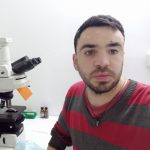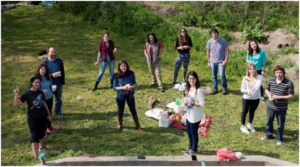Aquatic Ecology Laboratory
Heads
- Horacio E. Zagarese, PhD - Superior Researcher CONICET af honorem zagarese@intech.gov.ar

- Fernando Unrein, PhD - Principal Researcher CONICET. Adjunct Professor UNSAM funrein@intech.gov.ar
Members

- Leonardo Lagomarsino, PhD - Adjunct Researcher CONICET. Teaching assistant UNSAM lagomarsino@intech.gov.ar

- Nadia Diovisalvi, PhD - Adjunct Researcher CONICET. Teaching Assistant UNSAM nadiadiovisalvi@intech.gov.ar

-
Gladys Janet Santucho - Doctoral Fellow CONICET janetsantucho@intech.gov.ar

- Rodrigo Sebastián Fernández - Doctoral Fellow CONICET rfernandez@intech.gov.ar

- Matías Omar Mariani - Doctoral Fellow CONICET mariani@intech.gov.ar
Support Staff

- José F. Bustingorry - Main professional CONICET bustingorry@intech.gov.ar

- Roberto U. Escaray - Main professional CONICET escaray@intech.gov.ar

- Marcela A. Ferraro - Head of practical work UNSAM marcelaferraro@intech.gov.ar
Research Lines
The phototrophic picoplankton (PPP) plays a key role in aquatic microbial trophic webs. PPP is represented by eukaryotic (picoeukariotes, Peuk) and prokaryotic (picocyanobactreia, Pcy) algae <2 µm. The knowledge available to date indicates the existence of different global patterns: (a) the abundance of PPP increases with trophic degree, (b) its contribution to the total phytoplankton biomass decreases, (c) the relative abundance of Pcy related to Peuk is higher in oligotrophic environments, (d) the Pcy rich in phycocyanin (PC) dominate turbid environments, unlike those rich in phycoerythrin (PE) that prevail in more transparent systems, and (e) the abundance of Pcy remains relatively low during most of the year except for one or two peaks in spring-summer. Studies carried out in pampean shallow lakes suggest that some of these patterns do not occur in this region: (1) more than 90% of PPP are Pcy despite being eutrophic environments, (2) the peak of Pcy abundance occurs in winter time, and (3) the contribution of PPP to total phytoplankton is much higher than expected, considering that many Pcy can aggregate together to form colonies, part of the phytoplankton >2 µm would be represented in fact by picoplanktonic algae. These observations motivate our research and lead us to question whether these environments really represent an exception. The main objective is to study the factors that determine the presence, abundance and dynamics of picoplanktonic algae in the pampean shallow lakes. The hypothesis is that the Pcy and Peuk spatiotemporal patterns observed in these lakes are mainly determined by the composition of the predators and by the underwater quality of light.
The phototropic picoplankton (PPP), represented by picocyanobacteria (Pcy) and picoeukaryotic algae (Peuk), is usually very abundant and contributes significantly to the phytoplankton biomass and the primary production of lakes and oceans. Due to their small size, the morphological features are insufficient to allow them to be taxonomically discriminated. During the last decade, the application of molecular biology techniques to the study of aquatic microorganisms revealed the existence of an astonishing phylogenetic and functional diversity. Compared to the oceans, the heterogeneity of continental water bodies is much greater, which allows us to hypothesize that freshwater picoplankton algae present higher phylogenetic and functional diversity than what is known to date, and even much higher than marine systems. The main objective of this project is to study the phylogeny, diversity and geographic distribution of picoplanktonic algae in fresh water environments.
For this purpose, the picoplanktonic algae populations are sorted using the flow cytometer and analyzed their molecular diversity, applying Illumina MiSeq. Unlike the classic technique based on environmental DNA sequencing from the concentration of the sample by filtration, our original approach allows direct association of morphological information with genetics. The construction of phylogenetic trees based on the sequences of 18S or 16S rDNA (for Peuk or Pcy respectively) and the design of primers for the groups of greatest interest, will allow studying the diversity of these groups in environmental samples applying highthrougput sequencing techniques such as Illumina MiSeq. The relationship of the diversity of PPP with the physical-chemical variables measured in each of the environments allows detecting patterns and associating the presence and geographic distribution of the main taxa with the environments in which they are found.
Eutrophic shallow lakes are generally subjected to cyanobacteria blooms. Unlike other temperate lakes, most of pampean shallow lakes are permanently dominated by unicellular and colonial forms of picocyanobacteria (Pcy) that do not generate blooms. Laboratory experiments had demonstrated that diverse strains of Pcy can aggregate as a response to predation pressure by bacterivorous protists. Our studies from Lake Chascomús suggests that the composition of the zooplankton is the main factor structuring the community of picoplanktonic cyanobacteria, directly or indirectly determining its abundance, composition and size distribution (i.e. percentage of cells aggregated into colonies). This research line is focused on studying the structuring effect of predation and viral infection over picocyanobacteria communities in Pampean shallow lakes. This research has complementary approaches: (a) monitoring the abundance and morphological and molecular composition of planktonic communities in several lakes within the region; (b) in situ and in vitro experiments to evaluate the effect of predators over the composition and phenotypic plasticity of phytoplankton; (c) molecular analysis of the digestive vacuoles content in bacterivorous protist isolated from the lakes, in relation with the environmental phytoplankton composition (availability of prey).
In recent decades, the effect of anthropic activities on the planet’s climate became evident. Globally, the average surface temperature increase by 0.13 ° C has from 2005 to 2015 (https://data.giss.nasa.gov/gistemp/maps/). However, there are important differences in the intensity of change in different areas of the planet. In the Southern Hemisphere (HS), and particularly in Argentina, climate change has shown trends that differ from those that have occurred in the Northern Hemisphere (HN), probably due to the unequal distribution of the continental and oceanic masses. Despite the great diversity of biological responses to climate change, three types of responses are often considered quasi-universal. The first one is the displacement of the geographical distribution of species or communities towards higher latitudes or altitudes. The second consists of the Spring anticipation, or more rarely the autumn delay, of seasonal biological events (phenology). The third ecological response is the reduction of average size at the individual, population or community level (Daufresne et al., 2009). There also remarkable differences in the amount of available information between the northern and southern hemispheres. Most studies on the effects of climate change on biological communities correspond to ecosystems in the northern hemisphere, and to a lesser extent Australasia and Antarctica. While South America and Africa are notably under-represented. Based on the above considerations, the general objective of this line of research is to study the effects of climate change on the size of zooplankton from shallow Pampean lakes.
Globally, the most conspicuous problem regarding water quality is eutrophication, a result of increasing loads of nutrients inputs that considerably deteriorate the beneficial uses of water. Shallow lakes are distinctive features of the Salado River basin (Buenos Aires, Argentina) and are closely associated with their regional economies, through its exploitation as tourism, recreational and fishing resources. These shallow systems provide fundamental services for communities developing in these watersheds, both directly, through the provision of food and water, as indirectly through climate control, mitigation of floods and droughts, and the cycling of organic matter, among others. The pristine state of these shallow systems was one where the vast majority was characterized by a clear-water state, with abundant aquatic vegetation. Currently, the region is experiencing changes in climate and land use that directly affect these lakes and many of them have switched to a turbid hypertrophic state due to increased nutrients loads entering the watershed by human activity. These environmental changes can modify the functioning of these aquatic systems, through alterations in sediment and dissolved nutrient contributions.
Microorganisms are the most diverse and functionally important organisms on Earth. They carry out the bulk of decomposition and catalyze important transformations in the nutrient cycles influencing the functioning of virtually all ecosystems. The ability to use organic substrates as a source of carbon and energy constitutes the fundamental basis of the functioning of the microbial community and the rest of the biogeochemical processes and ecological functions of the ecosystem necessarily depend on this capacity. As human activities reshape microbial communities worldwide, from global climate change to antibiotics in the human body, it is crucial to understand how microbial functional stability can be preserved, and how environmental change might erode this stability. A focus on the phenotypic characteristics of microorganisms—their traits—offers a path to interpret microbiome variation and its connection to the health and functioning of environmental, engineered, and human systems.
Within this context, this research line focuses the analysis on the functional attributes of microbial communities from eutrophic shallow lakes from the pampa plain. These waterbodies are conspicuous features in the landscape and constitute a valuable natural resource, in economic, cultural, aesthetic, scientific and educational terms. Hence, efforts made to expand our knowledge on the effects of climate change-related processes on the functioning of these natural systems and their application in conservation and management policies are critical to the interests of our nation and government. Therefore, our general objective is to analyze the functional features of microbial communities from eutrophic shallow lakes from Argentina exhibiting contrasting alternative states, to infer the drivers of communities’ functional attributes and to evaluate its implications on ecosystem functioning under the current scenario of anthropogenic activities driving climate change
Only a very small fraction of viruses are cultivable from the environment, and we do not have a universal gene to assess their diversity. Metagenomic approaches circumvent these limitations and allow studying viral diversity in natural systems. Furthermore, metagenomic tools allow identifying prophages (i.e. lysogenic viruses) and clustered regularly interspaced short palindromic repeats (i.e., CRISPR, bacterial defense systems) within bacterial genomes, and consequently studying virus-host interactions. In contrast to the extensive surveys of marine viruses, relatively little is known about the fundamental aspects of freshwater virus ecology. A high viral infection rate has been postulated for eutrophic aquatic systems. Previous studies revealed that viral lysis can remove up to 100% of the heterotrophic bacterial production and drastically reduce cyanobacterial blooms in these ecosystems. Viruses selectively infect fast-growing bacteria and thereby suppress competitive bacterial species, process known as “killing the winner”. Virus-host interactions dictate key biological processes such as horizontal gene transfer and shape microbial diversity, consequently influencing biogeochemical cycles. Thus, ecosystems functioning of eutrophic aquatic systems should be highly impacted by the virioplankton. This research line studies viral diversity and virus-bacteria interactions in eutrophic aquatic habitats within (1) the pampean wetland and (2) the Cierva Point wetland complex (Antarctic Peninsula).
Publications
Gilabert AS, López‐Abbate C, Flombaum P, Unrein F, Arbilla LA, Garzón‐Cardona JE, Martinez AM, Ibarbalz FM, Vincent F, Saraceno M, Ruiz‐Etcheverry LA, Ferronato C, Guinder VA, Silva R, Uibrig RA, D’Agostino V, Loizaga R, Lara RJ. Planktonic drivers of carbon transformation during different stages of the spring Bloom at the Patagonian Shelf‐break front, Southwestern Atlantic Ocean. Biogeochemistry 168, 10. 2025. https://doi.org/10.1007/s10533-024-01192-6
Yong Macias P, Ferraro M, Bustingorry JF, Escaray R, González Sagrario MdlA, Llames ME. Flooding events reshape bacterioplankton assemblages and functional properties in a hypertrophic Shallow Lake (Laguna Chascomús, Argentina). Hydrobiologia. En prensa. https://doi.org/10.1007/s10750-025-06031-9
Díaz M, Lagomarsino L, Mataloni G, Beltrán M, Libertelli M, Fermani P. Environmental changes affect picoplanktonic composition in Antarctic Peninsula ponds. Advances in Polar Science 35, 108-122. 2024. https://doi.org/10.12429/j.advps.2023.0018
Gayol MP, Dogliotti AI, Lagomarsino L, Zagarese HE. Temporal and spatial variability of turbidity in a highly productive and turbid shallow lake (Chascomús, Argentina) using a long time-series of Landsat and Sentinel-2 data.Hydrobiología 4177–4199. 2024. https://doi.org/10.1007/s10750-024-05574-7
Quiroga MV, Stegen JC, Mataloni G, Cowan D, Lebre PH, Valverde A. Microdiverse bacterial clades prevail across Antarctic wetlands. Molecular Ecology 33:e17189. 2024. https://doi.org/10.1111/mec.17189
Schiaffino MR, Quiroga MV, Metz S, Arboleda C, Padulle ML, Alonso C, Unrein F, Izaguirre I, Sarmento H. Inequality in academic publishing: Latin American Researchers Against the Odds. Issue 83. 2024. https://www.doi.org/10.5281/zenodo.10324505
Gerea M, Soto Cárdenas C, García PE, Quiroga MV, Queimaliños C. Contrasting dissolved organic matter biodegradation and bacterial cytometric features in oligotrophic and ultraoligotrophic Patagonian lakes. Journal of Plankton Research, fbad033. 2023. https://doi.org/10.1093/plankt/fbad033
Llames ME, Quiroga MV, Schiaffino MR. Research in ecosystem services provided by bacteria, archaea, and viruses from inland waters: synthesis of main topics and trends over the last ca. 40 years. Hidrobiología 850, 2671-2690. 2023 https://doi.org/10.1007/
Mariani M, Vignatti A, Echaniz S, Cueto G, Zagarese H, Diovisalvi N. Zooplankton community size structure across lakes within a semi-arid landscape: the effect of temperature and salinity. Journal of Plankton Research, fbad016. 2023. https://doi.org/10.1093/plankt/fbad016
Menezes M, Junger PC, Kavagutti VS, Wanderley B, de Souza Cabral A, Paranhos R, Unrein F, Amado AM, Sarmento H. Temporal patterns of picoplankton abundance and metabolism on the western coast of the equatorial Atlantic Ocean. Ocean and Coastal Research 71.2.2023. https://doi.org/10.1590/2675-2824071.22048mm
Quiroga MV, Capeletti J, Carusso S, Cochero J, García PE, Llames ME, Morandeira NS. Limnología con R. Universidad Nacional de La Plata. Facultad de Ciencias Naturales y Museo. La Plata. ISBN 978-950-34-2316-5. 2023. https://limno-con-r.
Sánchez ML, Izaguirre I, Zagarese H, Schiaffino MR, Castro Berman M, Lagomarsino L, Chaparro G, Baliña S, Vera MS, Spence Cheruvelil K. Drivers of planktonic chlorophyll a in pampean shallow lakes. Ecological Indicators 146, 109834. 2023. https://doi.org/10.1016/j.ecolind.2022.109834
Viver T, Conrad R, Lucio M, Harir M, Urdiain M, Gago JF, Suárez-Suárez A, Bustos-Caparros E, Sanchez -Martinez R, Mayol E, Fassetta F, Pang J, Gridan IM, venter S, Santos F, Baxter B, Llames ME, Cristea A, Banciu H, Hedlund BP, Rosello-Mora R. Description of two cultivated and two uncultivated new Salinibacter species, one named following the rules of the bacteriological code: Salinibacter grassmerensis sp. nov.; and three named following the rules of the SeqCode: Salinibacter pepae sp. nov., Salinibacter abyssi sp. nov., and Salinibacter pampae sp. nov. Systematic and Applied Microbiology 46, 126416. 2023 https://doi.org/10.1016/j.syapm.2023.126416
Castro Berman M, O´Farrel I, Huber P, Marino D, Zagarese H. A large-scale geographical coverage survey reveals a pervasive impact of agricultural practices on plankton primary producers. Agriculture, Ecosystems & Environment 325, 107740. 2022. https://doi.org/10.1016/j.agee.2021.107740
Costa MRA, Sarmento H, Becker V, Bagatini IL; Unrein F. Phytoplankton phagotrophy across nutrients and light gradients using different measurement techniques. Journal of Plankton Research 44, 508-521. 2022. https://doi.org/10.1093/plankt/fbac035
Fermani P, Lagomarsino, L, Torremorrell A, Escaray R, Bustingorry J, Llames M, Pérez G, Zagarese H, Mataloni G. Divergent dynamics of microbial components in two temperate shallow lakes with contrasting steady states in the Southern Hemisphere. Anais da Academia Brasileira de Ciências 94, e20191545. 2022. https://doi.org/10.1590/0001-
Fermani P, Llames ME, Diovisalvi N, Quiroga MV, Huber P, Zagarese H, Unrein F. Comunidades planctónicas y tramas tróficas acuáticas. En “Laguna de Chascomús: Aportes de la Ciencia para su mejor conocimiento”. Editado por Berasain GE, Miranda LA. Ministerio de Desarrollo Agrario de la Provincia de Buenos Aires, La Plata, Argentina.pp. 79-94. 2022.
Izaguirre I, Zagarese H, O´Farrel I. The limnological trace of contemporaneous anthropogenic activities in the Pampa Region. Ecología Austral. En prensa. http://ojs.ecologiaaustral.
Lagomarsino L, Bustingorry J, Escaray R, Zagarese H. Características fisicoquímicas y dinámica de nutrientes de la laguna de Chascomús. En “Laguna de Chascomús: Aportes de la Ciencia para su mejor conocimiento” Editado por Berasain GE, Miranda LA. Ministerio de Desarrollo Agrario de la Provincia de Buenos Aires, La Plata, Argentina. pp. 66-78. 2022.
Lozada M, Zabala MS, García PE, Diéguez MC, Bigatti G, Fermani P, Unrein F, Dionisi HM. Microbial assemblages associated with the invasive kelp Undaria pinnatifida in Patagonian coastal waters: structure and alginolytic potential. Science of the Total Environment 830, 154629. 2022. https://doi.org/10.1016/j.scitotenv.2022.154629
Metz S, Huber P, Mateus-Barros E, Junger PC, de Melo M, Bagatini IL, Izaguirre I, Cámara dos Reis, Llames ME, Accattatis V, Quiroga MV, Devercelli M, Schiaffino MR, Niño-García JP, Bastidas Navarro M, Modenutti B, Vieira H, Saraceno M, Sabio y García CA, Pereira E, Gonzalez-Revello, Piccini C, Unrein F, Alonso C, Sarmento H. A georeferenced rRNA amplicon database of aquatic microbiomes from South America. Scientific Data 9, 565. 2022. https://doi.org/10.1038/s41597-022-01665-z
Metz S, Huber P, Accattatis V, Lopes dos Santos A, Bigeard E, Unrein F, Chambouvet A, Not F, Lara E, Devercelli M. Freshwater protists: unveiling the unexplored in a large floodplain system. Environmental Microbiology 24, 1731–1745. 2022. https://doi.org/10.1111/1462-2920.15838
Nuozzi G, Seoane Rocha C, Sagua M, Llames ME, Huber P, Metz S, Lagomarsino L, Schiaffino MR. Estructura y dinámica del bacterioplancton en cuatro lagunas pampeanas de la cuenca del río Salado (Buenos Aires, Argentina). Ecología Austral. En prensa.
Orellana LH, Francis TB, Ferraro M, Hehemann JH, Fuchs BM, Amann RI. Verrucomicrobiota are specialist consumers of sulfated methyl pentoses during diatom blooms. The ISME Journal 16, 630 – 641. 2022. https://doi.org/10.1038/
Quiroga MV, Casa V, García PE, Küppers GC, Mataloni G. Diversity patterns across aquatic communities from peat bogs in changing environmental scenarios. En «Freshwaters and Wetlands of Patagonia. Natural and Social Sciences of Patagonia». Editado por Mataloni G, Quintana RD. Springer Nature. pp. 117-135. 2022. https://doi.org/10.1007/
Quiroga MV, Valverde A, Mataloni G, Casa V, Stegen JC, Cowan D. The ecological assembly of bacterial communities in Antarctic wetlands varies across levels of phylogenetic resolution. Enviromental Microbiology 24, 3486-3499. 2022. https://doi.org/10.1111/1462-2920.15912
Doubek J, Anneville O, Lewandowska A, Patil V, Rusak J, Salmaso N, Straile D, Urrutia-Cordero P, Venail P, Adrian R, Alfonso M, De Gasperi C, De Eyto E, Gaiser E, Girdner S, Graham JL, Grossart HP, Hejzlar J, Jacquet S, Kirillin G, Llames ME, Matsuzaki SI, Nodine E, Piccolo M, Pierson D, Rimmer A, Rudstam L, Sadro S, Swain H, Thackeray S, Thiery W, Verburg P, Zohary T, Stockwel, J. The extent and variability of storm-induced temperature changes in lakes measured with long-term and high frequency data. Limnoloogy and Oceanography 66, 1979–1992. 2021 https://doi.org/10.1002/lno.11739
Fermani P, Metz S, Balgué V, Descy JP, Morana C, Logares R, Massana R, Sarmento H. Microbial eukaryotes assemblages and potential novel diversity in four tropical East-African great lakes. FEMS Microbiology Ecology 97, fiab 114. 2021. https://doi.org/10.
Izaguirre I, Unrein F, Schiaffino MR, Lara E, Singer D, Balagué V, Gasol JM, Massana R. Phylogenetic diversity and dominant ecological traits of freshwater Antarctic Chrysophyceae. Polar Biology 44: 941–957. 2021. https://doi.org/10.1007/s00300-021-02850-3
O´Farrel I, Sanchez ML, Schiaffino MR, Izaguirre I, Huber P, Lagomarsino L, Yema L. Human impacted shallow lakes in the Pampean plain are ideal hosts for cyanobacterial harmful blooms. Environmental Pollution 288, 117747. 2021. https://doi.org/10.1016/j.
Quiroga MV, Huber P, Ospina-Serna J, Diovisalvi N, Odriozola M, Cueto GR, Lagomarsino L, Fermani P, Bustingorry J, Escaray R, Zagarese H, Unrein F. The dynamics of picocyanobacteria from a hypereutrophic shallow lake is affected by light-climate and small-bodied zooplankton: a 10-year cytometric time-series analysis. FEMS Microbiology Ecology 97, fiab055. 2021. https://doi.org/10.1093/
Sánchez ML, Schiaffino MR, Graziano M, Huber P, Lagomarsino L, Minotti P, Zagarese H, Izaguirre I. Effect of land use on the phytoplankton community of Pampean shallow lakes of the Salado River basin (Buenos Aires Province, Argentina). Aquatic Ecology 55, 417-435. 2021. https://doi.org/10.1007/
Zagarese HE, Gonzalez Sagrario MdelosA, Wolf-Gladrow D, Nöges P, Nöges T, Kangur K, Ichiro S, Matsuzaki SIS, Kohzu A, Vanni MJ, Ozkundakci D, Echaniz SA, Vignatti A, Grosman F, Sanzano P, Van Dam B, Knoll LB. Patterns of CO2 concentration and inorganic carbon limitation of phytoplankton biomass in agriculturally eutrophic lakes. Water Research 190, 116715. 2021. https://doi.org/10.1016/j.watres.2020.116715
Castro Berman M, Llames ME, Minotti P, Fermani P, Quiroga MV, Ferraro MA, Metz S, Zagarese, HE. Field evidence supports former experimental claims on the stimulatory effect of glyphosate on picocyanobacteria communities. Sci Total Environ. 701: 134601. 2020. https://doi.org/10.1016/j.scitotenv.2019.134601
Huber P, Metz S, Unrein F, Mayora G, Sarmento H, Devercelli M. Environmental heterogeneity determines the ecological processes that govern bacterial metacommunity assembly in a floodplain river system. The ISME Journal 14, 2951-2966. 2020. https://doi.org/10.1038/s41396-020-0723-2
Odriozola M, Zagarese HE, Diovisalvi N. Zooplankton hatching from dormant eggs in a large Pampean shallow lake. Hydrobiologia 847, 2097–2111. 2020. https://doi.org/10.1007/s10750-020-04233-x
Ospina-Serna J, Huber P, Odrizola M, Fermani P, Unrein F. Picocyanobacteria aggregation as a response to predation pressure: direct contact is not necessary. FEMS Microbiology Ecology 96, fiaa153. 2020. https://doi.org/10.1093/femsec/fiaa153
Sathicq MB, Unrein F, Gómez N. Recurrent pattern of picophytoplankton dynamics in estuaries around the world: The case of Río de la Plata. Marine Environmental Research 161, 105136. 2020. https://doi.org/10.1016/j.marenvres.2020.105136
Stockwell JD, Doubek JP, Adrian R, Anneville O, Carey CC, Carvalho L, De Senerpont Domis LN, Dur G, Frass MA, Grossart HP, Ibelings BW, Lajeunesse MJ, Lewandowska AM, Llames ME, Matsuzaki SIS, Nodine ER, Nõges P, Patil VP, Pomati F, Karsten K, Rudstam LG, Rusak JA, Salmaso N, Seltmann CT, Straile D, Thackeray SJ, Thiery W, Cordero PU, Patrick Venail P, Verburg P, Woolway RI, Zohary T, Andersen MR, Bhattacharya R, Hejzlar J, Janatian N, Kpodonu ATNK, Williamson TJ, Wilson HL. Storm impacts on phytoplankton community dynamics in lakes. Glob Change Biol 26, 2756-2784. 2020. https://doi.org/10.1111/gcb.15033
Calzadilla PI, Vilas JM, Escaray FJ, Unrein F, Carrasco P, Ruiz OA. The increase of photosynthetic carbon assimilation as a mechanism of adaptation to low temperature in Lotus japonicus. Science Reports. 9: 863. 2019. https://doi.org/10.1038/s41598-018-37165-7
Fontanarrosa MS, Rojas Molina F, AlFonso MB, García de Souza, J, Diovisalvi N. Animales abundantes y diminutos en la laguna: El zooplancton. En: “Destino: La Barrancosa. Una invitación a conocer las lagunas pampeanas”. Editado por: Grosman F, Sanzano P, Bertora, A. Universidad del Centro de la Provincia de Buenos Aires. Pp: 164-172. 2019. ISBN 978-950-658-495-5
Gerea M, Queimaliños C, Unrein F. Grazing impact and prey selectivity of picoplanktonic cells by mixotrophic flagellates in oligotrophic lakes. Hydrobiologia 831: 5-21. 2019. https://doi.org/10.1007/s10750-018-3610-3
Lagomarsino L, BustIngorry J, Escaray RU. ¿Qué son “los nutrientes” en los ecosistemas acuáticos? En: “Destino: La Barrancosa. Una invitación a conocer las lagunas pampeanas”. Editado por: Grosman F, Sanzano P, Bertora, A. Universidad del Centro de la Provincia de Buenos Aires. Pp: 126-129. 2019. ISBN 978-950-658-495-5
Gerea M, Quiroga MV, Unrein F. Los organismos más diminutos de Laguna La Barrancosa: El picoplancton. En: “Destino: La Barrancosa. Una invitación a conocer las lagunas pampeanas”. Editado por: Grosman F, Sanzano P, Bertora, A. Universidad del Centro de la Provincia de Buenos Aires. Pp: 144-149. 2019. ISBN 978-950-658-495-5
Huber P, Cornejo-Castillo FM, Ferrera I, Sánchez P, Logares R, Metz S, Balagué V, Acinas SG, Gasol JM, Unrein F. Primer design for an accurate view of picocyanobacterial community structure by using high-throughput sequencing. Applied and Environmental Microbiology. 85: e02659-18. 2019. https://doi.org/10.1128/AEM.02659-18
Lozano VL, Miranda CE, Vinocur AL, González C, Unrein F, Wolansky MJ, Pizarro HN. Turbidity matters: differential effect of a 2,4-D formulation on the structure of microbial communities from clear and turbid freshwater systems. Heliyon 5: e02221. 2019. https://doi.org/10.1016/j.heliyon.2019.e02221
Metz S, Lopes Dos Santos A, Berman MC, Bigeard E, Licursi M, Not F, Lara E, Unrein F. Diversity of photosynthetic picoeukaryotes in eutrophic shallow lakes as assessed by combining flow cytometry cell-sorting and high throughput sequencing. FEMS Microbiology Ecology. 95: fiz038. 2019. https://doi.org/10.1093/femsec/fiz038
Metz S, Singer D, Domaizon I, Unrein F, Lara E. Global distribution of Trebouxiophyceae diversity explored by high-throughput sequencing and phylogenetic approaches. Environimental Microbiology. 21: 3885-3895. 2019. https://doi.org/10.1111/1462-2920.14738
Schiaffino MR, Diovisalvi N, Marfetán Molina D, Fermani P, Li Puma C, Lagomarsino L, Quiroga MV, Pérez GL. Microbial food-web components in two hypertrophic human-impacted Pampean shallow lakes: interactive effects of environmental, hydrological, and temporal drivers. Hydrobiologia 830: 255–276. 2019. https://doi.org/10.1007/s10750-018-3874-7
Singer D, Metz S, Unrein F, Shimano S, Mazei Y, Mitchell EAD, Lara E. Contrasted micro-eukaryotic diversity associated with sphagnum mosses in tropical, subtropical and temperate climatic Zones. Microbiology Ecology. 78: 714-724. 2019. https://doi.org/10.1007/s00248-019-01325-7
Wanderley BMS, Araújo DSA, Quiroga MV, Amado AM, Neto ADD, Sarmento H, Metz SD, Unrein F. flowDiv: a new pipeline for analyzing flow cytometric diversity. BMC Bioinformatics. 20: 274. 2019. https://doi.org/10.1186/s12859-019-2787-4


